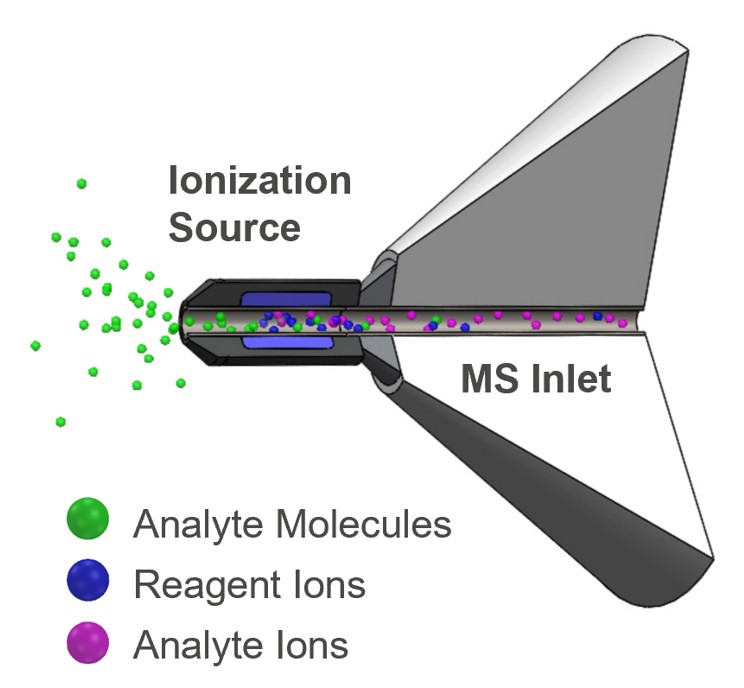
Differences between DART and SICRIT® in Mass Spectrometry
When labs look for an ambient ion source for direct mass spectrometry, they inevitably come across DART and SICRIT®. The key question then is: What are the differences between DART and SICRIT®? – and most labs are looking for practical answers, not just theory. Both ion sources were developed to make direct mass spectrometry (Direct-MS) possible, enabling fast, chromatography-free analysis of solids, liquids, and gases. But their design and usability differ in ways that strongly affect speed, reproducibility, and integration.
This article explains the core differences between both ambient ionization solutions, highlighting where each fits into modern lab workflows, and why SICRIT® has become the more flexible, reproducible, and future-ready solution for many applications.
What is DART?
DART, or Direct Analysis in Real Time, is one of the earliest and most widely adopted ambient ionization methods. It generates metastable species from a carrier gas such as helium or nitrogen, which ionize analytes positioned in the open air between the source and the mass spectrometer. DART enables rapid, non-contact measurements of solids, liquids, or gases directly at atmospheric pressure.
Key characteristics of DART:
- Uses noble gases, typically helium at 3–5 L/min.
- Open-gap geometry requires the sample to be positioned between the source and MS inlet.
- Elevated temperatures promote desorption and ionization.
- Quantitative analysis generally relies on internal standards
Applications include fast screening in forensics, pharmaceutical quality control, and food safety.
Schematic Diagram Of A DART Ion Source
Credits: Rbcody, CC BY-SA 4.0, via Wikimedia Commons
What is SICRIT®?
SICRIT®, or Soft Ionization by Chemical Reaction in Transfer, is a modern ion source technology based on dielectric barrier discharge ionization within a flow-through capillary. The source is mounted directly at the mass spectrometer inlet, where volatile or vaporized analytes are drawn in by the vacuum and ionized on their way into the system by means of a ring-shaped cold plasma. This indirect ionization process ensures soft ionization, and an efficient ion transfer. The unique geometry enables a wide range of applications on top of direct MS.
Key characteristics of SICRIT®:
- Operates with various gases, including ambient air, without consumables.
- Flow-through geometry supports reproducible ion transfer.
- Gas-tight configuration enables controlled sample introduction.
- Compatible with LC, GC, SFC, autosamplers, robotic platforms, and MS imaging.
- Modular setup allows analysis of solids, liquids, and gases via direct desorption or connected modules.
- Low power consumption (~5 W) and compact design enable portable or inline use.

Applications range from environmental monitoring to clinical diagnostics, process control, and advanced research studies.
Key Differences Between DART and SICRIT®
| Parameter | DART | SICRIT® |
| Ionization Principle | Open-air ionization via metastable helium/nitrogen species | Dielectric barrier discharge via ring-shaped cold plasma ionization |
| Carrier Gas Requirement | Helium (3–5 L/min) or Nitrogen | Any carrier gas, including ambient air; no consumables |
| Sample Geometry | Open gap; Sample must fit between source and MS | No size restrictions; remote sampling possible |
| Quantitation | Requires internal standards | Headspace, SPME, and direct quantitation (dedicated modules required) |
| Integration | No LC/GC/SFC integration | Compatible with LC, GC, SFC, autosamplers, imaging setups (dedicated modules required) |
| Mass Spec compatibility | Bruker Systems only | Vendor independent |
| Mobility & Footprint | Requires gas cylinders; high power; limited portability | Small footprint; ~5 W power; suitable for portable or inline use |
When to Choose DART
DART remains a practical option for straightforward, open-air analyses where minimal setup and immediate results are priorities. It fits well in applications such as forensic screening, counterfeit drug detection, or surface analysis, where qualitative information is sufficient and quantitation is not required. Laboratories with existing Bruker systems are able to use the DART ion source effectively for rapid, point-of-use checks or quick sample comparisons without extensive integration needs.
When to Choose SICRIT®
SICRIT® is the preferred choice when workflows demand high reproducibility, quantitative capability, and integration with complementary analytical systems. It is particularly suited for laboratories performing continuous or automated measurements, such as environmental monitoring, clinical screening, or process control, where stable operation and low maintenance are essential. Research and development labs benefit from its compatibility with LC, SFC, GC, and MS imaging, allowing flexible switching between analytical modes without reconfiguration. SICRIT® also offers advantages in high-throughput testing, volatile compound analysis, and setups requiring portable or inline ion sources, where gas independence and compact design improve efficiency and reliability.
Conclusion
DART remains a well-established solution for rapid, direct analysis in open-air screening. SICRIT®, however, provides a more versatile and future-oriented approach, combining broad system compatibility, quantitative performance, and reproducible results. Its adaptability to automated, integrated, and high-throughput environments makes it the more practical choice for laboratories aiming to meet modern analytical demands.

